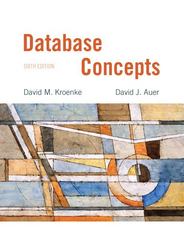Question
Need help creating the functions: spaces, draw-ascii-line, newlines, and draw-ascii-diagram. This code is in racket. Starting below this line ================================================================================================== #lang racket (provide (all-defined-out)) ;;
Need help creating the functions: spaces, draw-ascii-line, newlines, and draw-ascii-diagram. This code is in racket.
Starting below this line
==================================================================================================
#lang racket
(provide (all-defined-out))
;;
;; CIS352 (Fall '22) Project 1 -- ASCII Art
;;
;; To see the demo, invoke using:
;; racket ascii.rkt
;; READ, DON'T EDIT
;; A point is specified as a list of length three containing an (0)
;; X-column-index, (1) Y-column-index, and (2) character to draw at
;; the specified X/Y coordinate position.
;;
;; For example, '(5 4 #\+) specifies the point at (5,4) in the diagram
;; is #\+.
(define (point-spec? pt)
(match pt
;; points are lists of size three specifying a line, column, and
;; character to be printed
[`(,(? nonnegative-integer? line) ,(? nonnegative-integer? column) ,(? char? char)) #t]
[_ #f]))
;; a digram is a list of valid point-spec?s
(define (diagram-spec? l)
(and (list? l) (andmap (lambda (x) (point-spec? x)) l)))
;; Takes a list of strings, returns an (ordered) diagram-spec?
;;
;; The basic idea is to walk over each line using a recursive function
;; which tracks a counter for the line number. Within that function,
;; we split up the string into its constituent characters using
;; string->list and use a *second* recursive walk over each character,
;; tracking the column number.
(define (parse-ascii-diagram lines)
;; parse a single line, characters is a list of char?s line-no
;; is current line number.
(define (parse-line characters line-no)
;; for each character, chars is a list of char?s, col-no is
;; the number of the current column.
(define (for-each-char chars col-no)
(cond [(empty? chars) '()] ;; done, return
[(equal? (first chars) #\space)
;; if the char is a space, skip it
(for-each-char (rest chars) (add1 col-no))]
[else
(cons (list line-no col-no (first chars))
(for-each-char (rest chars) (add1 col-no)))]))
(for-each-char characters 0))
;; for each line, lines-list is the rest of the lines, line-no is
;; current line number.
(define (for-each-line lines-list line-no)
(if (empty? lines-list)
;; we're done, return
'()
(let ([characters (string->list (first lines-list))]
[rest-lines (rest lines-list)])
(append (parse-line characters line-no)
(for-each-line rest-lines (add1 line-no))))))
(for-each-line lines 0))
;; YOUR CODE HERE -- EDIT BEYOND THIS
;; helper: generate n spaces
(define (spaces n) (make-string n #\space))
;; Note: this is slightly different than the version in exercise e0,
;; but only superficially, a line number (which you should ignore) is
;; added.
;;
;; Assume `l` is a (length-3) list of points (defined above) whose
;; first element is a line number, second element is the column
;; position, and third element is the character to be rendered at that
;; line/column pair. You will return a string representing the line.
;;
;; Assume that all characters are on the same line--another function
;; will wrap this function.
;;
;; Example:
;; (draw-ascii-line '((3 3 #\=) (3 4 #\=) (3 5 #\=) (3 7 . #\.)
;; (3 9 #\=) (3 10 #\=) (3 11 #\=)))
;; > " === . ==="
(define (draw-ascii-line l)
;; for each point
(define (h l cur-pos)
(if (empty? l)
""
;; else
(let ([next-index (second (first l))]
[next-char (third (first l))]
[rest-list (rest l)])
;; TODO TODO TODO TODO
'todo)))
;; assume input is sorted ascending on column number
(h l 0))
;; Given a list of points, return the number of the next line. Assume
;; the list l is nonempty (calling this function on an empty list is
;; an error)
(define (line-number l)
(first (first l)))
;; Given a list of points, grab the next "line" from the input, return
;; (a) the next line and (b) the rest of the input.
(define (grab-next-line points)
;; conceptually: recur over l, consing on the next element as long
;; as it is on the next line
(define (h lst)
(match lst
['() (cons '() '())]
[`(,hd . ,rest) (if (equal? (first hd) (line-number points))
(let ([rest-ans (h rest)])
(cons (cons hd (car rest-ans)) (cdr rest-ans)))
(cons '() lst))]))
(h points))
;; generate a string of n newlines in a row
(define (newlines n)
;; TODO TODO TODO TODO
'todo)
;; Draw a whole ASCII diagram, given as a list of point
;; specifications.
;;(draw-ascii-diagram '((3 3 #\=) (3 4 #\=) (4 5 #\=) (4 7 #\.)
;; (4 9 #\=) (5 10 #\=) (5 11 #\=)))
(define (draw-ascii-diagram diagram)
(define (do-lines lst line-no)
(if (empty? lst)
""
(let* ([parsed-line (grab-next-line lst)]
[next-line (car parsed-line)]
[rest-list (cdr parsed-line)]
[next-line-no (line-number next-line)])
;; TODO TODO TODO TODO
'todo)))
(do-lines diagram 0))
;; DO NOT EDIT BELOW HERE
(define (demo file)
(define lines (file->lines file))
(define input (string-join lines " "))
(define diagram (parse-ascii-diagram lines))
(define answer (draw-ascii-diagram diagram))
(displayln "The input is:")
(displayln input)
(displayln "The decompiled diagram is:")
(pretty-print diagram)
(displayln "Rendering this diagram produces the following:")
(displayln (draw-ascii-diagram diagram)))
(define file
(command-line
#:program "ascii.rkt"
#:args ([filename ""])
filename))
;; if called with a single argument, this racket program will execute
;; the demo.
(if (not (equal? file "")) (demo file) (void))
Step by Step Solution
There are 3 Steps involved in it
Step: 1

Get Instant Access to Expert-Tailored Solutions
See step-by-step solutions with expert insights and AI powered tools for academic success
Step: 2

Step: 3

Ace Your Homework with AI
Get the answers you need in no time with our AI-driven, step-by-step assistance
Get Started


